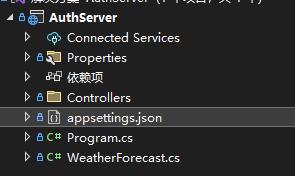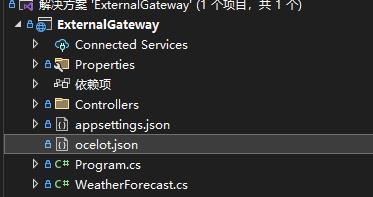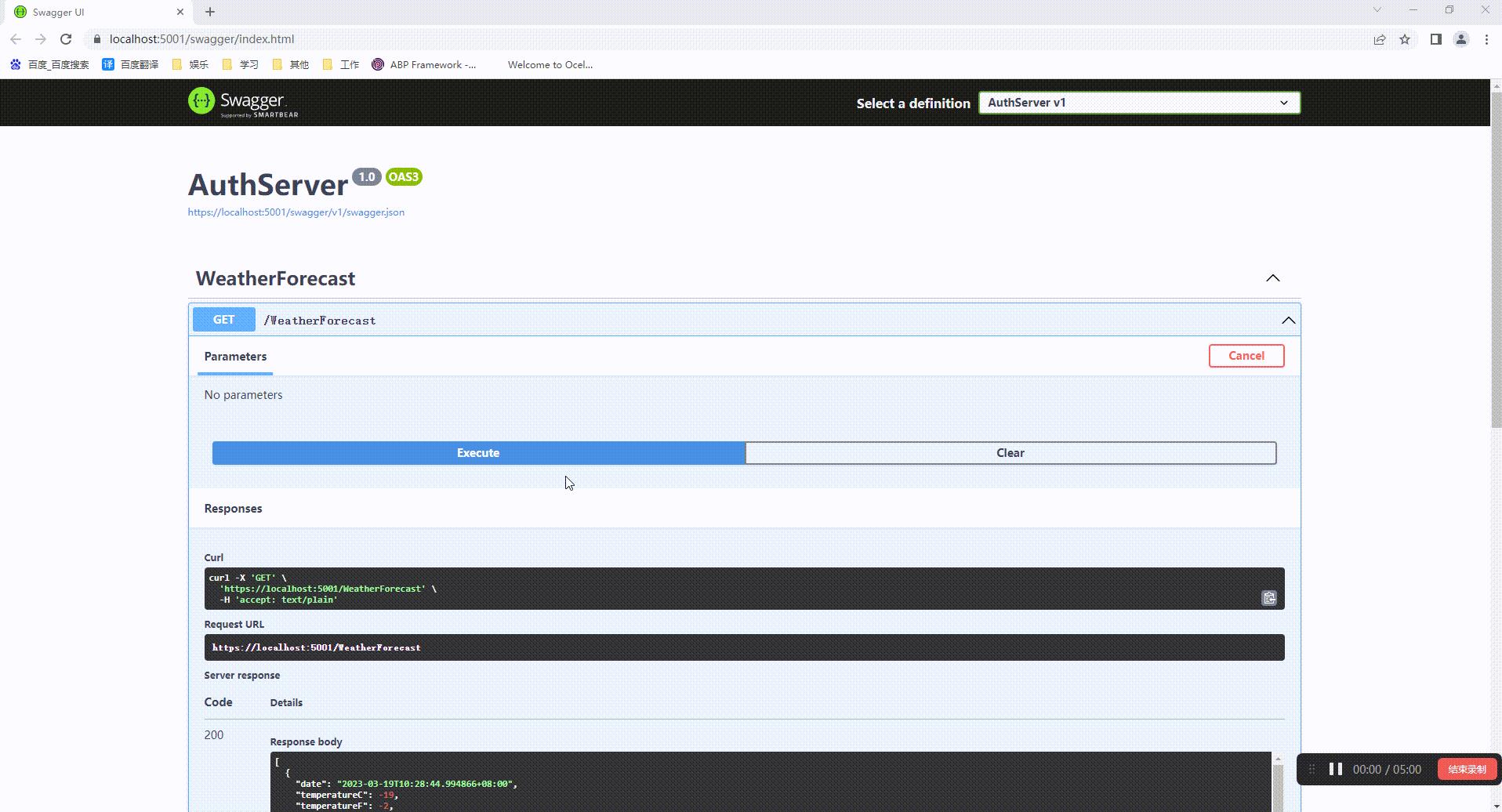Ocelot使用与设置路由Routing
Posted 我什么时候能变强啊!
tags:
篇首语:本文由小常识网(cha138.com)小编为大家整理,主要介绍了Ocelot使用与设置路由Routing相关的知识,希望对你有一定的参考价值。
一、安装Ocelot
在程序包管理器控制台输入以下命令安装Ocelot
Install-Package Ocelot
二、新建两个项目
我们新建两个.Net Core WebAPI项目如下:


直接就是最初始化的项目,只是我们在ExternalGateway项目中安装Ocelot,并且添加一个ocelot.json文件(也可以添加多个配置文件然后合并),文件内容如下:
"GlobalConfiguration": "BaseUrl": "https://localhost:5000" , "Routes": [ "DownstreamPathTemplate": "/everything", "DownstreamScheme": "https", "DownstreamHostAndPorts": [ "Host": "localhost", "Port": 5001 ], "UpstreamPathTemplate": "/api/everything", "UpstreamHttpMethod": [ "Get", "Post" ] ]
然后注入Ocelot的服务和配置请求管道
builder.Configuration.SetBasePath(Directory.GetCurrentDirectory()).AddJsonFile("ocelot.json", optional: false, reloadOnChange: true);
builder.Services.AddOcelot(); //...... app.UseOcelot().Wait();
然后我们运行两个项目就能通过ExternalGateway项目地址访问uthServer的地址

三、Routing的参数配置说明
1、路由
"DownstreamPathTemplate": "/everything", "DownstreamScheme": "https", "DownstreamHostAndPorts": [ "Host": "localhost", "Port": 5001 ], "UpstreamPathTemplate": "/api/everything", "UpstreamHttpMethod": [ "Get", "Post" ]
其中DownstreamPathTemplate、DownstreamScheme和DownstreamHostAndPorts定义了请求将被转发到的URL。
参数DownstreamHostAndPorts是一个集合定义了请求转到任何下游服务的主机和端口,一般是单个即可,但是如果存在负载均衡到下游服务那就需要填写多个,并进行相关的负载均衡的配置。
参数UpstreamPathTemplate是标识用于给定下游请求的DownstreamPathTemplate对应的URL。
参数UpstreamHttpMethod便于区分不同的HTTP的请求到相同的URL,可以设置为空允许全部的请求。
在Ocelot中可以以something的形式为模板中的变量添加占位符,但是该占位符变量必须同时出现在DownstreamPathTemplate和UpstreamPathTemplate的上下游配置中,Ocelot会尝试进行占位符值的替换。
默认请求路径的配置是不区分大小写的,如果需要修改通过以下参数配置:
"RouteIsCaseSensitive": true
2、全部捕获
在Ocelot中还支持捕获全部路径的路由,用户可以指定他们想要匹配的所有流量。
像是如下的配置,所有的请求都将被代理。但是占位符url的名称不重要,可以使用任何名称。
"DownstreamPathTemplate": "/url", "DownstreamScheme": "https", "DownstreamHostAndPorts": [ "Host": "localhost", "Port": 80, ], "UpstreamPathTemplate": "/url", "UpstreamHttpMethod": [ "Get" ]
但是全部捕获的优先级是最低的,如果存在其他配置,将会优先于此匹配。
3、优先级
可以通过Priorty参数来这是匹配上游请求路径的优先级,如下配置的情况下请求地址为/goods/delete的时候优先匹配/goods/catchAll,因为0是最低的优先级,Priorty越大优先级越高。
"UpstreamPathTemplate": "/goods/catchAll" "Priority": 0 "UpstreamPathTemplate": "/goods/delete" "Priority": 1
4、上游主机
参数UpstreamHost允许我们设置该路由的上游主机,配置后仅当请求头的主机为我们的配置值,才会匹配该路由配置。如果没有配置UpstreamHost那就是任何主机头都可以。
"DownstreamPathTemplate": "/", "DownstreamScheme": "https", "DownstreamHostAndPorts": [ "Host": "10.0.10.1", "Port": 80, ], "UpstreamPathTemplate": "/", "UpstreamHttpMethod": [ "Get" ], "UpstreamHost": "somedomain.com"
如上述代码仅当主机头为somedomain.com的请求,才会匹配上述路由。如果存在两个相同的路由配置,但是一个设置了UpstreamHost一个没有设置,这样会匹配设置了的路由。
5、查询字符串
在Ocelot中允许将查询字符串作为DownstreamPathTemplate的一部分,如下所示上游路径模板中的unitId将作为下游路径模板中的查询字符串参数unitId的值。
"Routes": [ "DownstreamPathTemplate": "/api/subscriptions/subscriptionId/updates?unitId=unitId", "UpstreamPathTemplate": "/api/units/subscriptionId/unitId/updates", "UpstreamHttpMethod": [ "Get" ], "DownstreamScheme": "http", "DownstreamHostAndPorts": [ "Host": "localhost", "Port": 50110 ] ], "GlobalConfiguration":
此外Ocelot还允许将查询字符串放置在UpstreamPathTemplate中,以便将某些查询匹配到对应的服务,如下所示只能匹配查询参数为unitId的请求。
"Routes": [ "DownstreamPathTemplate": "/api/units/subscriptionId/unitId/updates", "UpstreamPathTemplate": "/api/subscriptions/subscriptionId/updates?unitId=unitId", "UpstreamHttpMethod": [ "Get" ], "DownstreamScheme": "http", "DownstreamHostAndPorts": [ "Host": "localhost", "Port": 50110 ] ], "GlobalConfiguration":
四、聚合路由
在Ocelot中允许使用聚合路由,聚合路由就是将多个路由的结果结合成一个进行返回。
首先我们将ocelot.json改为下面的配置,可以看到两个路由下各自有自己的Key,然后多了一个聚合路由Aggregates里面设置了对应的两个Key,并且该聚合路由的路径也被设置为了/getweatherforecastaggregate/everything
"GlobalConfiguration": "BaseUrl": "https://localhost:5000" , "Routes": [ "DownstreamPathTemplate": "/everything", "DownstreamScheme": "https", "DownstreamHostAndPorts": [ "Host": "localhost", "Port": 5001 ], "UpstreamPathTemplate": "/api/everything", "UpstreamHttpMethod": [ "Get", "Post" ], "Key": "WeatherForecast1" , "DownstreamPathTemplate": "/everything", "DownstreamScheme": "https", "DownstreamHostAndPorts": [ "Host": "localhost", "Port": 5001 ], "UpstreamPathTemplate": "/api2/everything", "UpstreamHttpMethod": [ "Get", "Post" ], "Key": "WeatherForecast2" ], "Aggregates": [ "RouteKeys": [ "WeatherForecast1", "WeatherForecast2" ], "UpstreamPathTemplate": "/getweatherforecastaggregate/everything" ]
然后我们请求对应的地址就可以看到返回了以两个Key为键的对应路由地址接口返回的信息,如果接口报错则返回空。这里需要注意,聚合路由Aggregates中的上游路径UpstreamPathTemplate其实对应的就是Route中的UpstreamPathTemplate,也就是说路由中的上游路径就是聚合路由的下游路径,对应的变量占位符啥的都会传递。

如果我们不满意返回的结果可以自己重写聚合路由的返回,
以上是关于Ocelot使用与设置路由Routing的主要内容,如果未能解决你的问题,请参考以下文章